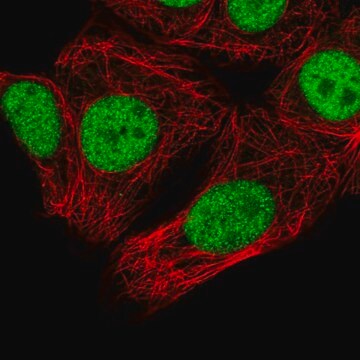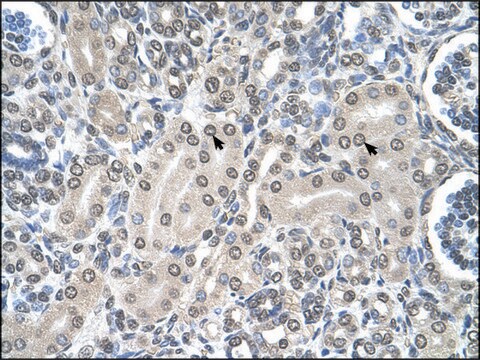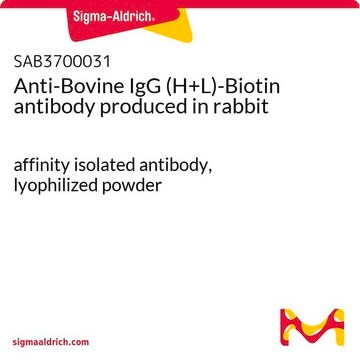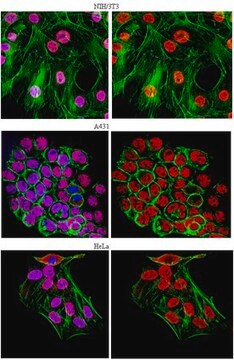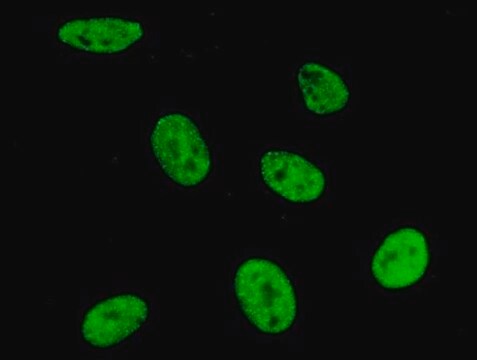추천 제품
생물학적 소스
rat
결합
unconjugated
항체 형태
purified from hybridoma cell culture
항체 생산 유형
primary antibodies
클론
4H12, monoclonal
양식
buffered aqueous solution
분자량
~20 kDa
종 반응성
human, mouse, rat, hamster, monkey
농도
~1.0 mg/mL
기술
immunocytochemistry: suitable
immunoprecipitation (IP): suitable
western blot: 1-2 μg/mL using HeLa or COS7 or CHO cell extracts
동형
IgG2a
UniProt 수납 번호
배송 상태
dry ice
저장 온도
−20°C
타겟 번역 후 변형
unmodified
유전자 정보
human ... SNRPC(6631)
mouse ... Snrpc(20630)
rat ... LOC685273(685273)
일반 설명
Monoclonal Anti-U1 snRNP C (U1C) (rat IgG2a isotype) is derived from the hybridoma 4H12 produced by the fusion of mouse myeloma cells (SP2) and splenocytes from a rat immunized with mouse U1C protein. Small nuclear ribonucleoprotein polypeptide C (U1C) is mapped to human chromosome 6p21.31.
The U1 snRNP complex contains the U1 snRNA molecule and the U1 snRNP specific proteins U1-70K, U1A and U1C, plus a common set of eight proteins, called Sm proteins U1A and U1-70K contain RNA binding domains and interact with naked snRNA on their own.
특이성
Monoclonal Anti-U1 snRNP C (U1C) recognizes human, monkey, mouse, rat, and hamster U1C.
면역원
mouse U1C protein fusion protein
애플리케이션
Anti-U1 snRNP C (U1C) antibody, Rat monoclonal has been used for:
- immunoblotting
- immunofluorescence
- immunoprecipitation
- immunocytochemistry
생화학적/생리학적 작용
The U1 small nuclear ribonucleoprotein particle (snRNP) has an important function in the early formation of the spliceosome, the multicomponent complex in which pre-mRNA splicing takes place. The binding of U1C to the U1snRNP particle is dependent on protein-protein interactions between U1C and U1-70K as well as U1C and the common Sm proteins.
U1A and U1−70K contain RNA binding domains and interact with naked snRNA on their own. In cultured HeLa cells, mutant U1C proteins that are not able to bind to the U1 snRNP do not accumulate in the nucleus, indicating that nuclear accumulation of U1C is due to incorporation of the protein into the U1 snRNP.
물리적 형태
Solution in 0.01M phosphate buffered saline, pH 7.4, containing 15 mM sodium azide
저장 및 안정성
Store at -20 °C. For continuous use, store at 2-8 °C for up to one month. For extended storage, freeze at -20 °C in working aliquots. Repeated freezing and thawing, or storage in “frost-free” freezers, is not recommended. If slight turbidity occurs upon prolonged storage, clarify the solution by centrifugation before use. Working dilution samples should be discarded if not used within 12 hours.
면책조항
Unless otherwise stated in our catalog or other company documentation accompanying the product(s), our products are intended for research use only and are not to be used for any other purpose, which includes but is not limited to, unauthorized commercial uses, in vitro diagnostic uses, ex vivo or in vivo therapeutic uses or any type of consumption or application to humans or animals.
적합한 제품을 찾을 수 없으신가요?
당사의 제품 선택기 도구.을(를) 시도해 보세요.
Storage Class Code
12 - Non Combustible Liquids
WGK
nwg
Flash Point (°F)
Not applicable
Flash Point (°C)
Not applicable
Byung Ran So et al.
Molecular cell, 76(4), 590-599 (2019-09-17)
Full-length transcription in the majority of human genes depends on U1 snRNP (U1) to co-transcriptionally suppress transcription-terminating premature 3' end cleavage and polyadenylation (PCPA) from cryptic polyadenylation signals (PASs) in introns. However, the mechanism of this U1 activity, termed telescripting, is
Crystal structure of human spliceosomal U1 snRNP at 5.5 AA resolution
Krummel DA, et al.
Nature, 458(7237), 475-475 (2009)
Binkai Chi et al.
Scientific reports, 8(1), 8755-8755 (2018-06-10)
Mutations in multiple RNA/DNA binding proteins cause Amyotrophic Lateral Sclerosis (ALS). Included among these are the three members of the FET family (FUS, EWSR1 and TAF15) and the structurally similar MATR3. Here, we characterized the interactomes of these four proteins
SMN2 splice modulators enhance U1--pre-mRNA association and rescue SMA mice
Palacino J, et al.
Nature Chemical Biology, 11(7), 511-511 (2015)
Interactome analyses revealed that the U1 snRNP machinery overlaps extensively with the RNAP II machinery and contains multiple ALS/SMA-causative proteins
Chi B, et al.
Scientific reports, 8(1), 8755-8755 (2018)
자사의 과학자팀은 생명 과학, 재료 과학, 화학 합성, 크로마토그래피, 분석 및 기타 많은 영역을 포함한 모든 과학 분야에 경험이 있습니다..
고객지원팀으로 연락바랍니다.